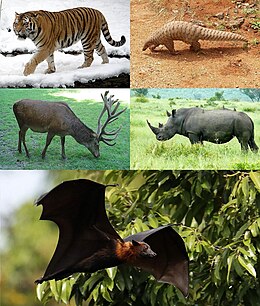Scrotifera
A Scrotifera ("herezacskóval harapó") a méhlepényesek egyik kládja, melybe beletartozik a denevérek rendje és a Ferungulata nagycsoportja, valamint az ő közös őseik. A molekuláris filogenetika tanúságai szerint a Scrotifera az Eulipotyphla rendjének testvércsoportja,[2] mellyel közösen alkotják a Laurasiatheria öregrendet. A Scrotifera fajainak utolsó közös őse nagyjából 73,1[3] 85,5 millió évvel[4] ezelőtt élt.
| Scrotifera | ||||||||||||||||||||
|---|---|---|---|---|---|---|---|---|---|---|---|---|---|---|---|---|---|---|---|---|
| Evolúciós időszak: Paleocén - Jelen | ||||||||||||||||||||

| ||||||||||||||||||||
| Rendszertani besorolás | ||||||||||||||||||||
| ||||||||||||||||||||
| Szinonimák | ||||||||||||||||||||
| ||||||||||||||||||||
| Alcsoportok | ||||||||||||||||||||
| ||||||||||||||||||||
| Hivatkozások | ||||||||||||||||||||
A Wikifajok tartalmaz Scrotifera témájú rendszertani információt. A Wikimédia Commons tartalmaz Scrotifera témájú kategóriát. |
Filogénje szerkesztés
2006-ban a Pegasoferae klád (melybe olyan emlős törzsek tartoztak, mint a Chiroptera, a Carnivora, a Perissodactyla és a Pholidota) létrehozatalát javasolták a Scrotifera kládon belül, s ennek a testvér rendje lett volna az Artiodactyla, melynek a molekuláris rendszerekben végzett genom elemzések voltak az alapjai.[5] Nem sikerült alátámasztani a csoport eggyétartozását, a modern vizsgálatok pedig arra utalnak, hogy ez a klád nem egy természetes csoportosítás.[4][6]
| A Scrotifera filogénje[2][4][7][8][9][10] | |||||||||||||||||||||||||||||||||
| |||||||||||||||||||||||||||||||||
| A kladogram alapja mitokondiális, molekuláris DNS- minták valamint fosszilis maradványok. |
Lásd még szerkesztés
Jegyzetek szerkesztés
- ↑ Springer M. S., Murphy W. J., Eizirik E., O'Brien S. J. In: "Placental Mammals: Origins and Relationships of the Major Clades." Rose K. D., Archibald J., editor. Baltimore: Johns Hopkins; (2005.) "Molecular evidence for major placental clades"; pp. 37–49
- ↑ a b Waddell, Peter J. (1999. március 1.). „Using Novel Phylogenetic Methods to Evaluate Mammalian mtDNA, Including Amino Acid-Invariant Sites-LogDet plus Site Stripping, to Detect Internal Conflicts in the Data, with Special Reference to the Positions of Hedgehog, Armadillo, and Elephant” (angol nyelven). Systematic Biology 48 (1), 31–53. o. DOI:10.1080/106351599260427. ISSN 1076-836X. PMID 12078643.
- ↑ dos Reis, Mario (2012. szeptember 7.). „Phylogenomic datasets provide both precision and accuracy in estimating the timescale of placental mammal phylogeny” (angol nyelven). Proceedings of the Royal Society B: Biological Sciences 279 (1742), 3491–3500. o. DOI:10.1098/rspb.2012.0683. ISSN 0962-8452. PMID 22628470.
- ↑ a b c Zhou, Xuming (2012. január 1.). „Phylogenomic Analysis Resolves the Interordinal Relationships and Rapid Diversification of the Laurasiatherian Mammals” (angol nyelven). Systematic Biology 61 (1), 150–64. o. DOI:10.1093/sysbio/syr089. ISSN 1063-5157. PMID 21900649.
- ↑ (2006) „Pegasoferae, an unexpected mammalian clade revealed by tracking ancient retroposon insertions”. Proceedings of the National Academy of Sciences 103 (26), 9929–9934. o. DOI:10.1073/pnas.0603797103. PMID 16785431.
- ↑ (2013) „Phylogenomic analyses elucidate the evolutionary relationships of bats (Chiroptera)”. Current Biology 23 (22), 2262–2267. o. DOI:10.1016/j.cub.2013.09.014. PMID 24184098.
- ↑ Peter J. Waddell, Hirohisa Kishino, Rissa Ota (2001.) "A Phylogenetic Foundation for Comparative Mammalian Genomics" Genome Informatics 12: 141–154
- ↑ O’Leary, M. A., Bloch JI, Flynn, J. J., Gaudin, T. J., Giallombardo, A., Giannini, N. P., Goldber, S. L, Kraatz, B. P., Luo, Z-X, Jin Meng, Xijun Ni, Novacek, M. J., Perini, F. A., Randall, Z. S., Rougier, G. W., Sargis, E. J., Silcox, M. T., Simmons, N. B., Spaulding, M. Velazco, P. M., Weksler, M., Wible, J. R. Cirranello, A. L. (2013.) "The Placental Mammal Ancestor and the Post–K-Pg Radiation of Placentals." Science 339:6120:662-667.
- ↑ Frank Zachos (2020.) "Mammalian Phylogenetics: A Short Overview of Recent Advances", In book: "Mammals of Europe – Past, Present, and Future" (pp.31-48)
- ↑ Xue Lv, Jingyang Hu, Yiwen Hu, Yitian Li, Dongming Xu, Oliver A. Ryder, David M. Irwin, Li Yu (2021.) "Diverse phylogenomic datasets uncover a concordant scenario of laurasiatherian interordinal relationships", Molecular Phylogenetics and Evolution, Volume 157

